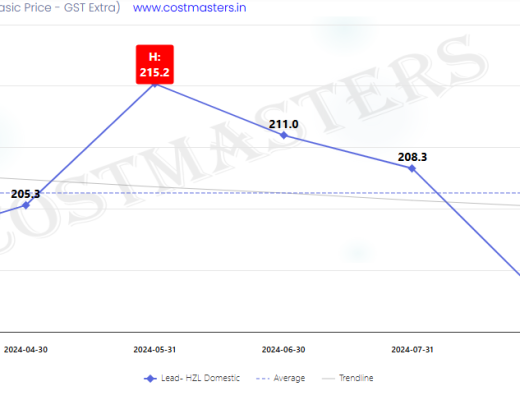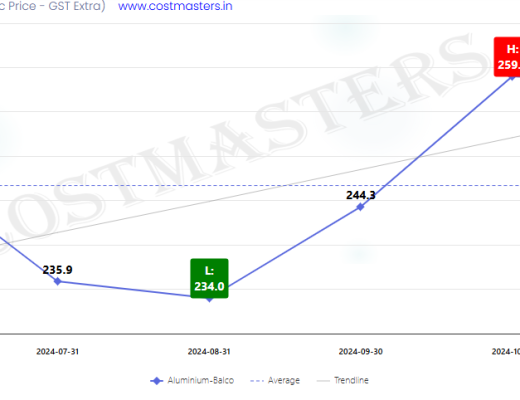Steel industry plays a very integral part in steering the $64 trillion Indian economy in a forward direction by pitching in almost 2% of the total GDP. The steel industry in India employs more than 5 lakh people directly and around 20 lakh people indirectly.
The modern Indian steel industry represents a powerful, independent and state of art disposition. With constant upgradation and modernization, we’ve successfully accomplished the global standards, when it comes to producing high-quality steel.
But the debate about the rising prices of steel goes on and around. Let us discuss this a little bit more about steel prices future in India.
Why are steel prices high in India?
There are several reasons why steel prices are high in India. First, India is a major importer of steel, and the country’s demand for steel has been growing in recent years. Additionally, India has placed several tariffs and other restrictions on imported steel, which has made it more expensive. Finally, the Indian government has provided several subsidies and other benefits to the domestic steel industry, which has also helped to keep prices high.
How have steel prices been trending in India?
India is a key player in the global steel market. Steel prices in India have been trending upwards in recent years due to several factors. Steel price have gone upto Rs 85/Kg in this year.

Why are steel prices high in India?
-The growing demand for steel in India. India is the world’s second-largest steel consumer, after China.
-The Indian government’s decision to impose a minimum import price on steel. This has made it more expensive to import steel into India, leading to higher prices for consumers.
-The depreciating value of the Indian rupee. Since steel is priced in US dollars, the depreciating rupee has made imported steel more expensive.
All of these factors have led to higher steel prices in India. However, there are signs that prices may soon start to fall, as the government has started to take steps to address the issue.
What are the major steel-consuming sectors in India?
The steel acts like the backbone of all the infrastructure and almost every sector requires steel. However, some sectors tend to be bigger consumers of steel and benefit the steel industry directly. The major steel-consuming sectors in India include- Construction- aiming for more than 60% of total steel consumption in India, followed by capital goods which consume almost 15% of the total steel produced, then comes the automotive sector, intermediate products sector, consumer durables and the railways consume around 3% of the total steel produced.
What are the major steel-producing companies in India?
India is one of the largest producers of steel. There are several major steel-producing companies in India.
Steel Authority of India is the largest steel producer in India, and it is a government-owned company.
There are a number of privately owned steel companies in India that contribute to the country’s production of this essential metal.
Some of the major steel producers in India include Jindal Steel, Tata Steel, and Essar Steel. These companies have all played a significant role in India’s steel industry and they continue to be major players in the market.
What are the government policies affecting steel prices in India?
In India, the steel industry is one of the most important sectors of the economy. The country is the world’s second-largest producer of steel, with an output of 118.2 million metric tonnes in FY 2021.
Given the importance of the steel industry, the government of India has implemented several policies to support the sector that play a significant impact on steel prices in the country.
The Government of India has taken several steps to ensure the vibrancy of the steel industry in the country. Some of these steps include providing financial and other support to the industry, imposing anti-dumping duties, and increasing the import duty on steel products.
What is the future outlook for steel prices in India?
The future outlook for steel prices in India is highly dependent on several factors, including global steel demand and production, the strength of the Indian economy, and Indian government policies.
Overall, global steel demand is forecast to grow modestly in the coming years. However, production is expected to increase at a faster pace, leading to lower prices. In India, economic growth is expected to continue, albeit at a slower pace than in recent years. Additionally, the Indian government is likely to continue its policies of supporting the domestic steel industry.
Taking all of these factors into account, steel prices in India are forecast to remain relatively stable in the coming years.
To wrap things up
As we conclude, it is important to reiterate that steel prices in India are constantly fluctuating. This is due to a variety of factors, such as global demand, production costs, and currency exchange rates. However, despite these fluctuations, steel prices in India have generally been on the rise in recent years.
If you are thinking of investing in the steel industry in India, it is important to keep an eye on these fluctuations and trends. By doing so, you can make informed decisions about when to buy and sell steel.
Disclaimer
While every attempt has been made to ensure that the information contained in this newsletter has been obtained from reliable sources, CostMasters will not responsible for any errors or omissions, or for the results obtained from the use of this information. Given the data collected from public domains there may be omissions or inaccuracies in information. All information in this site is provided “as is”, with no guarantee of completeness, accuracy, timeliness or of the results obtained from the use of this information. In no event will CostMasters, its related partners or employees thereof be liable for any decision made or action taken in respect to information published herewith.

